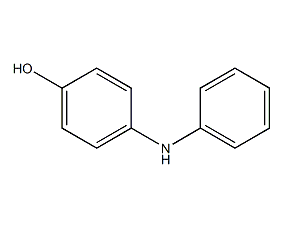
structural formula
| business number | 03ex |
|---|---|
| molecular formula | c12h11no |
| molecular weight | 185.22 |
| label |
p-hydroxydiphenylamine, 4-(phenylamino)phenol, 4-anilinophenol, 4-anilino-1-hydroxybenzene, 4-(n-phenylamino)phenol, 4-(phenylamino)-phenol, 4-hydroxydiphenylamine, p-hydroxydiphenylamine, p-anilinophenol, 4-(phenylamino)-pheno, rubber additives |
numbering system
cas number:122-37-2
mdl number:mfcd00020142
einecs number:204-538-9
rtecs number:sj6950000
brn number:511942
pubchem id:none
physical property data
1. character: the ordinary product is reddish brown melted body, the refined product is orange
2. melting point (℃):75~80
3. solubility: soluble in ethanol, ether, acetone, chloroform and benzene, slightly soluble in water, dilute alkali and inorganic acid.
toxicological data
1, acute toxicity: rat oral ld50: 3300mg/kg
mouse oral ld50: 2120mg/kg
mice were injected intravenously with ld50: 60mg/kg
unknown mammalian oral administration ld50: 3300mg/kg
ecological data
none yet
molecular structure data
1. molar refractive index:57.50
2. molar volume(m3/mol):153.9
3. isotonic specific volume(90.2k):415.6
4. surface tension(dyne/cm):53.1
5. dielectric constant:
6. dipole moment(10-24cm3) :
153.9
3. isotonic specific volume(90.2k):415.6
4. surface tension(dyne/cm):53.1
5. dielectric constant:
6. dipole moment(10-24cm3) :
7. polarizability:22.79
compute chemical data
1. reference value for hydrophobic parameter calculation (xlogp): none
2. number of hydrogen bond donors: 2
3. number of hydrogen bond acceptors: 2
4. number of rotatable chemical bonds: 2
5. number of tautomers: 4
6. topological molecule polar surface area 32.3
7. number of heavy atoms: 14
8. surface charge: 0
9. complexity: 158
10. number of isotope atoms: 0
11. determine the number of atomic stereocenters: 0
12. uncertain number of atomic stereocenters: 0
13. determine the number of chemical bond stereocenters: 0
14. number of uncertain chemical bond stereocenters: 0
15. number of covalent bond units: 1
properties and stability
none yet
storage method
1. storage
tightly sealed and protected from light.
synthesis method
2. introduction to production methods
produced by the reaction of aniline and hydroquinone; or obtained by the reaction of bromobenzene and p-aminophenol.
purpose
3. purpose
intermediates for pharmaceuticals, dyes, pesticides, and rubber additives.
alt: auto; mso-margin-bottom-alt: auto” align=left>7. polarizability:22.79
compute chemical data
1. reference value for hydrophobic parameter calculation (xlogp): none
2. number of hydrogen bond donors: 2
3. number of hydrogen bond acceptors: 2
4. number of rotatable chemical bonds: 2
5. number of tautomers: 4
6. topological molecule polar surface area 32.3
7. number of heavy atoms: 14
8. surface charge: 0
9. complexity: 158
10. number of isotope atoms: 0
11. determine the number of atomic stereocenters: 0
12. uncertain number of atomic stereocenters: 0
13. determine the number of chemical bond stereocenters: 0
14. number of uncertain chemical bond stereocenters: 0
15. number of covalent bond units: 1
properties and stability
none yet
storage method
1. storage
tightly sealed and protected from light.
synthesis method
2. introduction to production methods
produced by the reaction of aniline and hydroquinone; or obtained by the reaction of bromobenzene and p-aminophenol.
purpose
3. purpose
intermediates for pharmaceuticals, dyes, pesticides, and rubber additives.

 微信扫一扫打赏
微信扫一扫打赏

